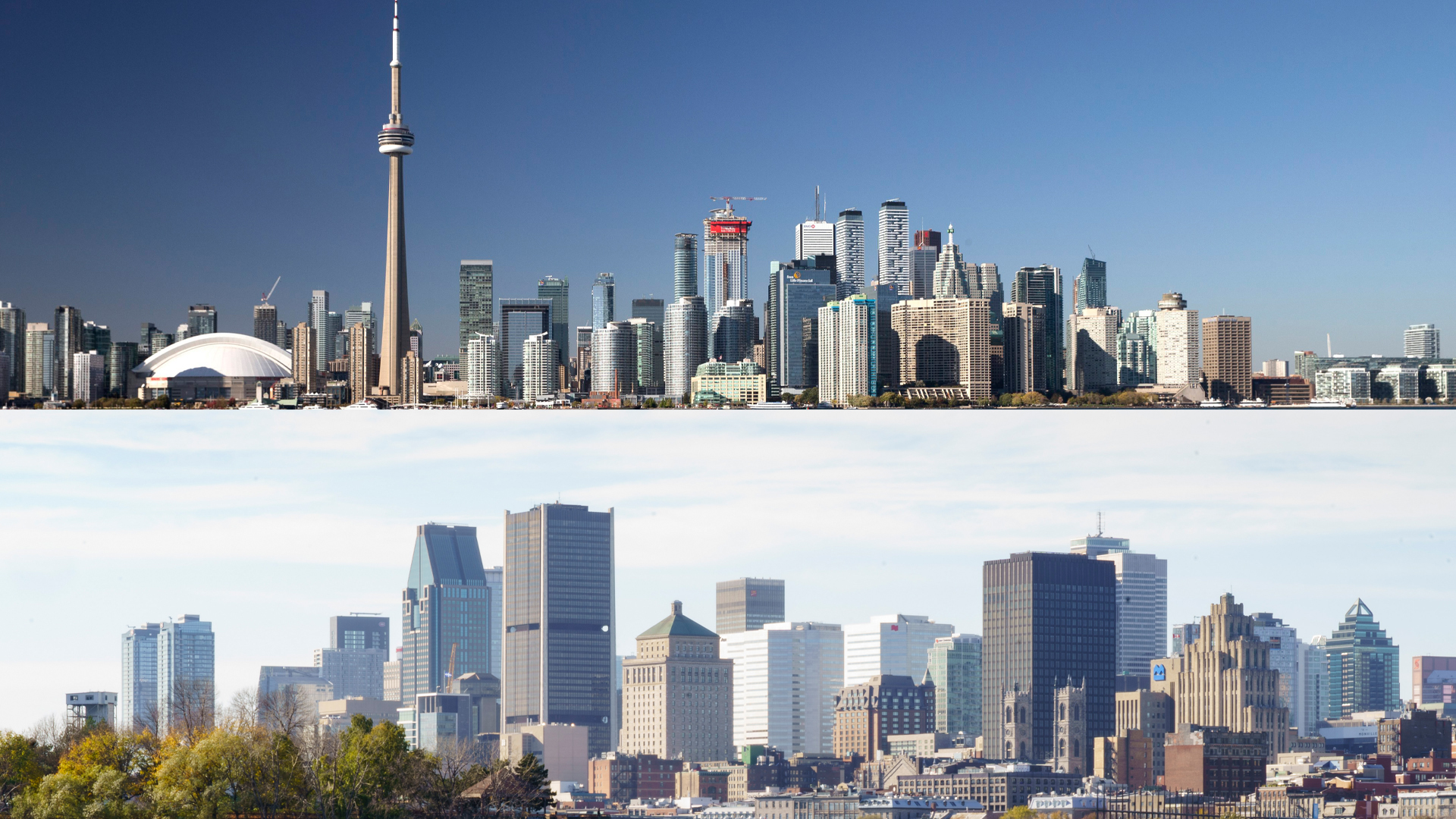
(Version française disponible ici)
Canada’s two largest cities are lively and exhilarating places. Toronto and Montreal each offers world-class performing arts, multiple research universities, vibrant and diverse cultural scenes, and great food. Beyond those achievements, though, two very divergent stories have been unfolding over the last few decades, one for better, one for worse.
Much of those differences can be boiled down to inconsistent governance at a regional level. Provincial governments in Ontario and Quebec possess sole authority to set up and foster structures to help Canada’s biggest cities succeed through greater regional collaboration.
The core difference between the Montreal and Toronto regions is that one has an additional layer of government sandwiched between municipal and provincial, while the other does not. The Montreal region’s Communauté métropolitaine de Montréal (the Montreal Metropolitan Community) (CMM) is comprised of members from 82 cities, towns, and villages from Greater Montreal. The Toronto region has no such level of government. It is split into five mini sub-regions (City of Toronto, Peel, Halton, Durham, and York) that consist of 25 municipalities. Little interregional connective tissue exists.
Toronto once had a second-tier regional government called Metro Toronto. It managed similar issues as the CMM in Montreal: regional planning, regional parks, waste disposal and transportation. Like today, postwar Toronto experienced explosive growth; infrastructure needs quickly outpaced what municipalities could provide. A regional body with a collective focus was essential to success. But in 1998, Metro Toronto was dismantled as part of Ontario’s “Common Sense Revolution,” a cost-cutting effort across the public sector.
Metro Toronto wasn’t the only victim. A non-exhaustive list of regions that lost their second-tier governments includes Winnipeg (1970), Halifax (1995), and Ottawa, Hamilton, and Sudbury (1999).
How to get cities out of their constitutional straitjacket
Our cities and city-regions need an urban policy observatory
More innovative transit, mixed-use development and cities’ essential workers
Abolishing second-tier government was a serious error. Western University professor Andrew Sancton has argued that second-tier governments enable self-governance by allowing separate local councils to collaborate strategically and avoid policy fragmentation. Yet only a few two-tier systems remain in Canada, including Vancouver’s Metro Vancouver, Victoria’s Capital Region District (CRP), Montreal’s CMM, and Quebec City’s Communauté métropolitaine de Québec (CMQ).
Despite the success of these institutions, the prevailing wisdom runs against interregional collaboration continues. Look no further than Edmonton’s recent decision to withdraw from a new regional transit commission that would have enhanced connections between the city and its suburbs.
Second-tier governance bodies are essential to urban success in Canada for three reasons.
First, cities are their regions: the success of one city is not possible without the others. All of Canada’s major cities have suburban and exurban municipalities ringing them. Because of the Canadian penchant for sprawl and subsequent spatial division between working and housing, suburbs often supply housing for workers who cannot afford to live in the city. Twenty-four per cent of workers in Vancouver live more than 15 kilometres from their workplaces; that balloons to 29 per cent in Montreal and a whopping 37 per cent in Toronto. The City of Vancouver even saw its population decrease in 2021. This means that major cities and their suburbs and exurbs are knit together by the labour market. As Canada plans to welcome hundreds of thousands more immigrants annually, regional planning between municipalities on issues like housing, transportation and waste management will help guarantee mutual success.
Second, some services are better provided at the regional level. Service delivery by local governments is a classic debate because it involves questions of economies of scale: which services are cheaper and more efficient to offer at scale and which services are better left to local governments? In the neoliberal era, the idea was that all services would be more efficient at scale. In reality, fusing municipalities meant in some cases costs increased instead.
Some services are better at the regional scale because they help remove friction for residents and goods. A robust example exists in public transit, where collaboration between municipalities’ services helps integrate factors like fare payments. Environmental issues are also regional issues: rivers, for example, are often shared between municipalities.

Third, and more controversially, empowered regional governments reduce the legitimacy of provincial interference in municipal affairs. This is not to say that provinces shouldn’t be involved, especially financially; the fiscal capacity of provinces is essential to achieving municipal goals. It is also provinces’ constitutional right to intervene. Cities are merely “creatures of the provinces” in Canada’s constitutional arrangement; their jurisdiction goes as far as provinces allow.
But just because it’s legal doesn’t make it acceptable. Provinces are naturally political actors responsible to voters far outside major cities. That means their incentives may not be in the best interests of urban voters. Many MPs may not even be aware of the issues they’re voting on, may never have walked in the urban forests they intend to raze. The issue is that in the absence of an empowered regional governing body, provinces are freer to intervene and structure urban politics on their whims. They effectively act as the regional body and the connective tissue between municipalities.
Here, the diverging paths between Ontario and Quebec become clearer. Take the issue of green spaces and biodiversity. The province of Ontario is removing 7,400 acres (or 30 square kilometers) from its Greenbelt, the ring of forests, farms, and waterways that ring the Toronto region, in order to build suburban housing. Or take its plan to build a new highway through four of the five regions, Highway 413, through… more wetlands, farms, forests, and waterways. Some municipalities are for Highway 413, some are against; there is no cohesive perspective. Imagine if the municipalities could plan and agree together through a second-tier government empowered to find the right solution.
By contrast, look at Montreal’s new planning on greenspace and biodiversity. At COP15 in December, the CMM increased its pledge to protect 22.3 per cent of the Montreal region’s greenspace to 30 per cent. It’s through these plans, as well as a new bylaw adopted by the entire CMM, that the region has been able to collaborate, strategize, and buy the land to direct its use away from worse usages. Another project, the Grand parc de l’Ouest, required interregional collaboration: it crosses two boroughs of the City of Montreal and four independent towns and villages, and was facilitated by both the platform provided and strategic plans adopted by the CMM.
The idea that provinces be willing to relinquish control to second-tier governments may seem far-fetched in some jurisdictions. But giving cities and regions the tools they need to collaborate with each other is an urban governance solution worth exploring.
An earlier version of this article stated that Ontario would be reducing Toronto’s greenbelt by 7400 hectares. In fact, it’s 7400 acres, or about 3000 hectares. Or 30 square kilometers.












